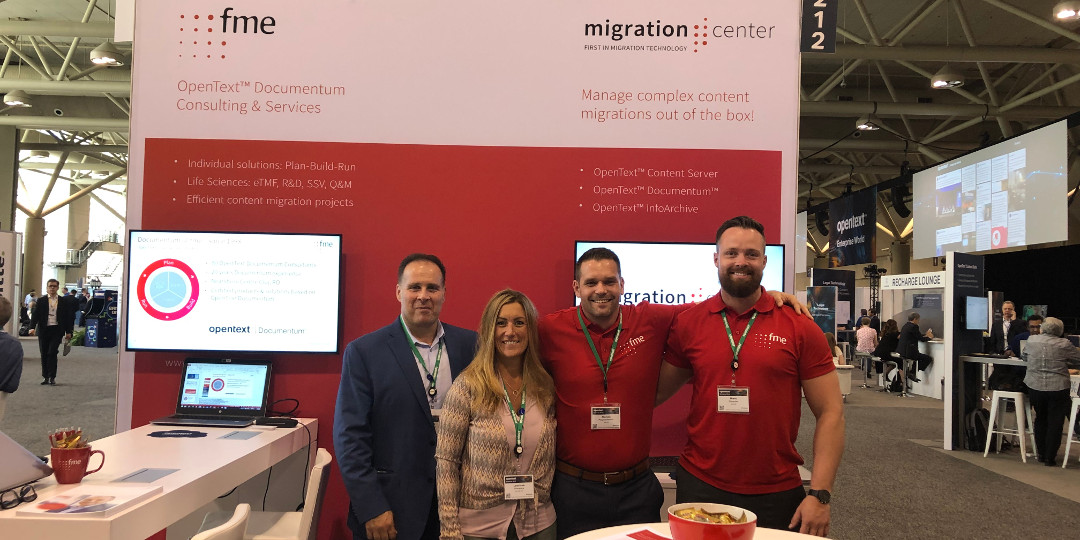On top of that, there are additional challenges as a result of mergers and acquisitions. Once they come together, companies are forced to consolidate documents and data from different systems and sources. Further, there is high pressure to reduce the on-premise footprints of enterprise applications – and with that, maintenance and personnel costs.
So, it’s always good to keep on top of these trends and get the latest solutions available to respond to these changing dynamics. We were happy to join the OpenText Enterprise World Conference in Toronto earlier in July to hear the latest news.
We were out in force with our product, services and sales teams meeting clients at our booth and with our technical staff joining the variety of sessions and labs as much as they could manage. Overall, the conference provided a good overview of the status and roadmaps of the components of the OpenText and Documentum product suite.

In case you missed the meeting or were looking for the latest updates, here are some of the highlights from this year’s conference:
- For the Documentum platform, it is good to see that there are improvements and enhancements happening across the platform. Cloud is of course one of the big drivers, and all components are on the path to support containerization to allow for easier deployment and management in cloud environments.
- Documentum Cloud Edition is the next generation from OpenText and will be available in April 2020. It can run anywhere – off or on cloud – and there will be no need to worry about upgrades again.
- On the InfoArchive side, the latest version offers connectivity to Azure Blob storage to store archive storage (unstructured content and more) for lowest cost of ownership, and the next versions will continue to support more cloud storages like Google Cloud storage, NetApp Storage Grid, and AWS Storage.
Working primarily on front-end topics I was especially interested in the following:Working primarily on front-end topics I was especially interested in the following:
- Good news – Webtop will not disappear just yet. Though it will just be maintained, there is no end-of-life announced at this point. While it is not the client of future, this will at least buy a bit more time for clients to decide which direction to go for their future user interface. Main clients for Documentum remain as before – D2 for content-centric applications and xCP for process-centric applications. An integration or merge is not planned at this point.
- In addition, the D2 SmartUI has come into play. The goal is to come up with a (close-to) unified user interface across the OpenText applications – Content Server and Documentum. It should simplify the access to the stored documents as well as provide easy access to integrated systems. For D2, it uses a big part of the D2 Configurations. It also will be the base for the mobile app to provide access from devices.
Another big topic at the meeting was the extension of some of the advanced OpenText features to the Documentum platform. One of them is the SAP integration with the Extended ECM Adaptor for SAP. Also, this integration can be exposed for end users through the Smart UI.
Working heavily with customers in the life sciences industry, I was of course eager to find out what is planned there as well.
- On the Documentum front-end side, the Documentum for Life Sciences suite will remain the major front end. The cloud-based Life Sciences Express client uses the same D2 configurations and is planned to replace the Classic UI more and more in future, additional features are still being added there to turn it into a full-feature client. The goal is to provide an easy-to-use but feature-rich client that will run as a regular web application but will also allow mobile device users to efficiently work with the application.So far, the application is focused on read-only use cases but there is a plan to extend it with the required document management capabilities. Some glimpse of that could be caught during the Innovation Lab – and it looked very promising.The classic Documentum Life Sciences suite will still be extended and enhanced, but pure user interface and usability improvements are being targeted for the LS Express client only moving forward. Further business-process-specific cloud applications are planned to enhance the client portfolio. The Quality CAPA application had been published before and was enhanced some more, and a new Regulatory Planning application is in the queue now and is targeted to be developed in close interaction with interested customers.
Finally, on the innovation front, the other big topic was – of course – the use of artificial intelligence (AI). During the keynote sessions, it was noted that all companies should now consider themselves “information companies,” making it important to find ways to put information into business context. Whether to comply with regulations or to create efficiencies to accelerate time-to-market, AI technologies can be leveraged.

All in all, the conference provided several opportunities for clients to connect and exchange experiences. Thanks a lot for the interesting conference (and for the “Paws for the Break” – such cute puppies) and I’m looking forward to seeing everyone next year in Vegas!
 fme AG
fme AG fme SRL
fme SRL
